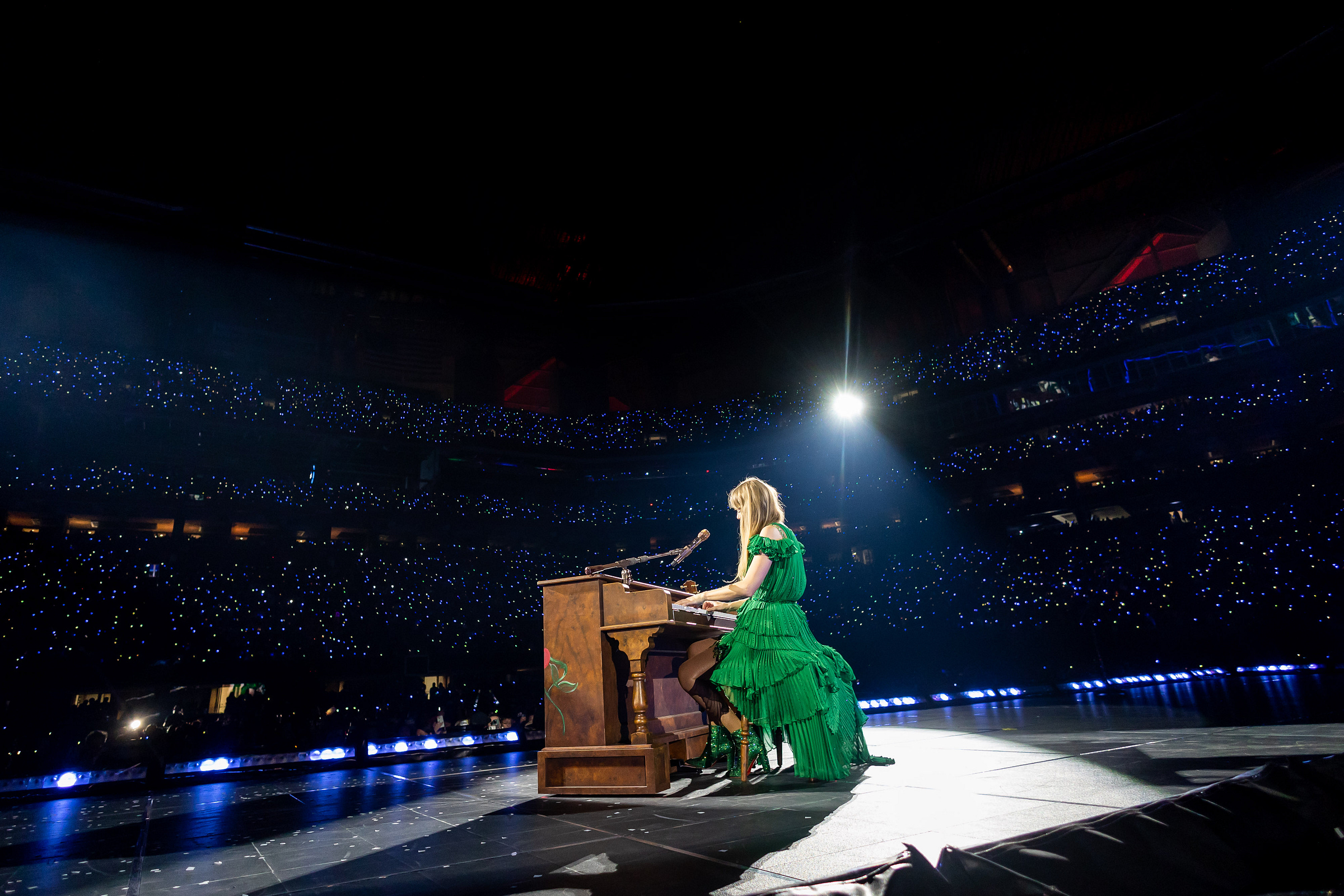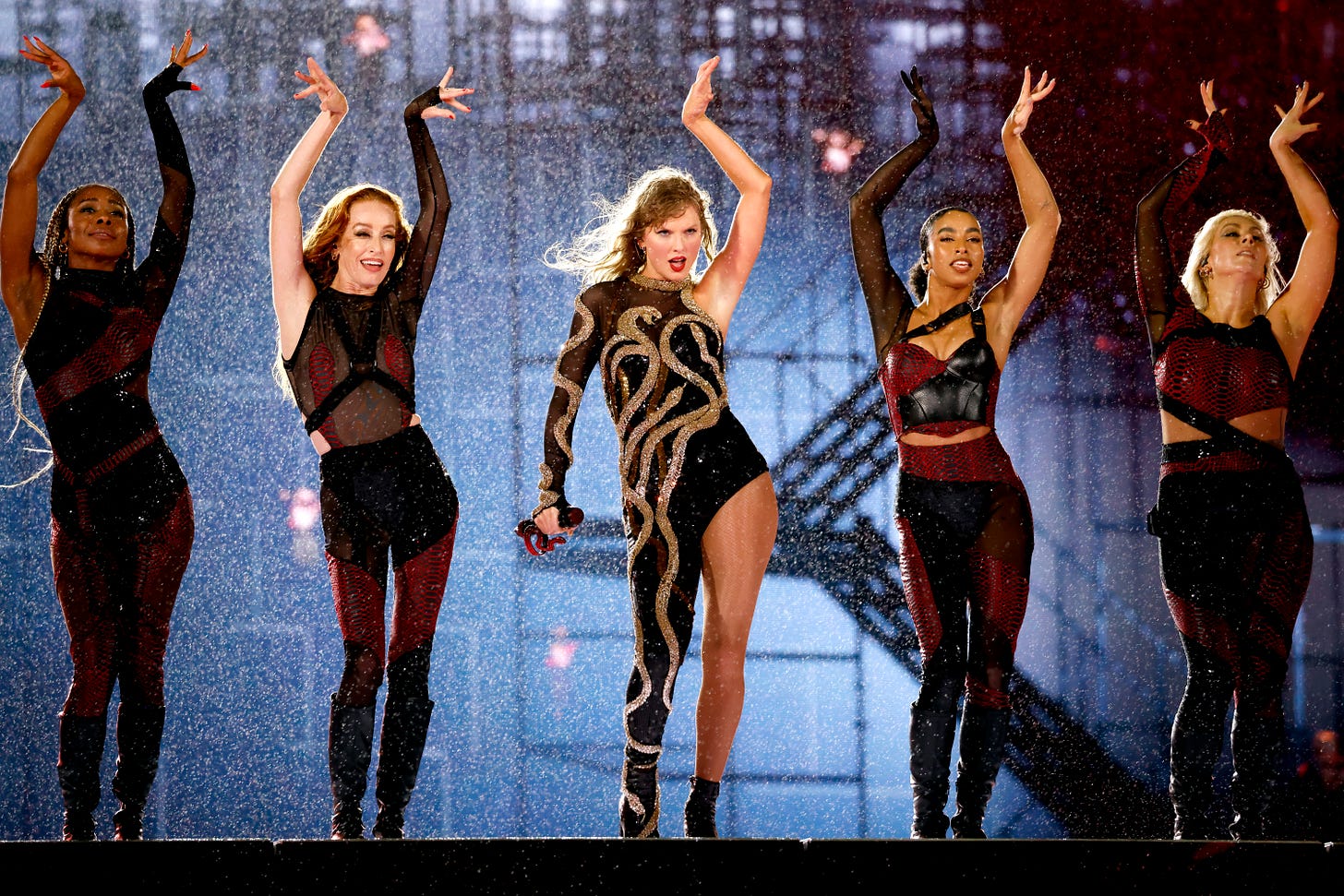A Master Class In Artistic Ownership
My take on Taylor's journey to reclaim her work and the road from here
Six years later, Taylor’s first six albums have found their way back home. In a letter on her website, Taylor details how she has successfully purchased back her masters. “To say this is my greatest dream come true is actually being pretty reserved about it,” she wrote.
In reading Taylor’s letter — so much finger pinching and zooming! — a few things jumped out at me. I’d love to know if they piqued your interest too.
Below is a rundown on the announcement and its implications, including:
A background of Taylor’s masters dispute. Where it all started and how we got here today.
The reported purchasing value of the catalogue now and what it means for the re-records project as a whole.
Speaking of the re-records, my thoughts on those two outstanding (Taylor’s Version) albums plus the possible the hidden TS12 clues in Taylor’s letter that caught my eye.
Most of all, why does this matter? It’s not an exaggeration to say that Taylor’s masters dispute has been historic. Her bravery and ongoing battle for artistic rights will continue to have ripple effects in the industry. We already know that she’s inspired younger artists to more carefully consider their contracts and pursue options that will allow them to own their work from the jump. Emotionally, of course, it’s also incredibly meaningful that such a personal body of work is now owned by the person who experienced it.
Would love to hear your thoughts on this latest news and all that it means for Taylor and her artistry. It’s all Taylor’s Version now, after all. Click below to share in the comments.
📧 Email: This is going to get cut off in your inbox. Best to view it in app or in browser.
💟 Engagement Matters: If you’re not currently in a position to become a paid subscriber, please consider becoming a free subscriber + hitting the ‘🤍’ heart button on this post. Any/all engagement helps creators tremendously.
In case you need a refresher on Taylor’s masters dispute, an overview for you. Taylor released her first six albums under her previous label Big Machine Label Group (BMLG). When her contract expired in she signed a new deal with Republic Records and Universal Music Group in 2018 which she later extended in 2020.
A significant draw of her Universal deal was the ability to own her music outright. In her announcement on Instagram, Taylor described it as “really important to [her] to see eye to eye with a label regarding the future of our industry.” Music copyrighting is two-pronged: publishing rights and masters rights. As songwriter, Taylor owns the publishing rights - the rights relating to the composition, lyrics, and melody - to all of her music. However, her masters - the actual recording of her music - were owned by her label. Royalties from music are subsequently divided amongst shareholders under varying circumstances. Units sold, streams, airplay, and live performances as just a few examples. These are determined by the copyright holders.
🎤 American Music Awards: The note on live performances also has a history in Taylor’s masters dispute, particularly relevant in light of the recent return of the American Music Awards. I give a recap on this in my AMA recap below.
Another key business vertical? Licensing. Like the use of a song in media like television or film. As publishing rights owner, Taylor has always been able to block undesired usage of her songs in this manner. She has, however, never been able to control royalty distribution. Under her new contract with Universal, from Lover onwards Taylor entered into complete creative ownership of her works.
This appealed greatly to Taylor as the biggest dispute she had with BMLG was their withholding of her masters ownership. According to Taylor in a letter she posted to her socials, renewing her contract with Big Machine would have meant “earning” the rights to her masters one new release at a time. “I walked away because I knew once I signed that contract, Scott Borchetta would sell the label, thereby selling me and my future,” she wrote. She added, “I had to make the excruciating choice to leave behind my past.” In June 2019, BMLG (and by extension Taylor’s entire catalogue) was sold to music manager Scooter Braun’s Ithaca Holdings for $300 million. At the time, Variety reported the value of Taylor’s works in the sale alone as approximately $140 million. The sale to Braun, specifically, was added salt in the wound. Taylor described it in her letter as her “worst case scenario.” Taylor was also quick to announce her intention to re-record her music as soon as she was legally able. “It’s going to be fun, because it’ll feel like regaining a freedom and taking back what’s mine,” she told Billboard in December 2019.
The threat, and subsequent fan backlash, was enough to give Braun cold feet. He would go on to sell the catalogue just a year later in November 2020 for $405 million to investment firm Shamrock Holdings. It’s rumored that Braun clinched the sale by convincing Shamrock that Taylor’s threat to re-record was a bluff. At the time, Shamrock also extended an offer to Taylor to buy back her work. The offer, however, came with both an ironclad non-disclosure agreement to silence Taylor on speaking about Braun publicly in addition to his continued profiting of her work according to Taylor. “Scooter’s participation is a non-starter for me,” she wrote.
We’ve made it to present day! Taylor’s acquisition of her masters follows reports that Shamrock was finally willing to make, according to Variety, a “good-faith deal” to sell.
The New York Post was the first outlet to catch wind of the potential sale, claiming on May 21 that the catalogue would sell in the neighborhood of $600 million. This would have been an exorbitant twofold increase from the original sale price. These reports were later described by sources to Rolling Stone as “highly inaccurate.” How much Taylor spent is unclear and it’s unlikely a number will ever be publicly released. Though Billboard reported a tally of $360 million — a number that’s a far cry from the inflated value initially reported by the Post. What is clear, and has always been at the crux of this dispute, is that this was the opportunity she had long-awaited for to purchase her music outright and, as she put it, “with no strings attached, no partnership, with full autonomy.”
The alleged value Taylor paid for her albums reflects the “honest, fair, and respectful” intentions of Shamrock. But more significantly, it underscores the efficacy of Taylor’s re-recording project. While fans might be disappointed that the two remaining (Taylor’s Versions) won’t be coming as swiftly as we’d hoped, let’s call the project what it was: an ambitious business endeavor that was a means to an end. Pursuing the re-records was not Taylor’s first choice. She’s made it abundantly clear from the start that her preference was the opportunity to buy her music outright. Am I surprised she jumped at the chance when it was finally, albeit six years belatedly, offered to her? No. To Taylor, the re-records started as a strategic lever that put the hostage holders of her music under the heel of her sparkly stiletto. With each release cutting into profits, her point became more clear and more costly. For her to have acquired her masters after all this time, at the price she reportedly did, speaks volumes to her power and legacy. While some may view the project as a zero sum game given she acquired her masters after all, the legacy of her efforts extends far beyond just ownership of her own discography. I doubt there’s another artist with the power, the funds, the fanbase, and the gumption to embark on a project this daunting. This wasn’t just a win for Taylor, but hopefully a win that sets a precedent for other artists hoping to own their work. Particularly those who don’t have her resources to fight the way she did.
The driving force of Taylor’s successful re-records project was to produce copies of her work that she could own the rights to. But they also served as a threat to the profits of the people who owned her masters. By replicating the originals as closely as possible and encouraging fans to support her “version” of her songs, she devalued their original counterparts track by track.
Along the way the re-records became much more than that. I imagine both to Taylor and to fans. In my mind, they are emotionally tethered to the celebratory nature of the Eras Tour and emblematic of a stage performance that honored her life’s work in a beloved three hour spectacle. I truly believe that in revisiting the past versions of herself that she has been through the Eras Tour and the re-records was transformative and healing and valuable. It gave fans new and old the opportunity to live (or relive) the eras of our collective experience.


I can, however, also imagine the emotional exhumation of both the tour and the re-recording process was draining and exhausting. I think we see the halo effect the re-records had on the new albums she was recording. “Would’ve, Could’ve, Should’ve” and “The Manuscript” both feel like direct results of reliving the Speak Now and RED eras in service of their re-records. I ultimately applaud and respect Taylor getting to a place where she is now at peace with not having to fulfill fan demands at the cost of reliving things that were too painful for her to enter a studio for. Ultimately, I think fans need to remember these re-recorded works were never owed to us. While they may have become emblematic of something greater than their original intention, I feel it bears remembering their primary existence was a strategic business tool. The re-records were always intended to be a sonic knife twist to bring private equity to its knees in order to sell the rightful owner of this catalogue their life’s work. Of course, I can empathize with the very human rise and fall of excitement many of us had in looking forward to the release of these two albums in full. We’ve been on this journey together and it’s crossed the finish line in celebration — but not in the way we might have expected.
This leads to a common question I’ve been asked: Which version of Taylor’s music should we listen to? The re-recorded “(Taylor’s Version)” or the original “Reclaimed Version” as I’ve seen some refer to it as. I’ve always held the - perhaps controversial(!) - stance that life is too short to consume art you do not enjoy. While by and large I think the re-recorded tracks are equivalents, if not improvements, to their originals, I also feel there are a few rare exceptions that I have always deferred back to the original for as their re-records are striking in difference (to my ear) enough to be at their detriment. “Holy Ground” and “Style” are examples that immediately come to mind. Taylor now owning every version of her songs, to me, means guilt-free listening if you had previously elected to only consume “Taylor’s” version of songs. In short, my answer is that you should listen to the one that brings you the most joy. That is, after all, one of the most healing and wonderful elements of music.
In her letter, Taylor also addressed the status of her remaining two, and very much anticipated, unreleased re-recorded albums: her eponymous debut Taylor Swift (2006) and reputation (2017).
If I were to summarize, I would describe the ultimate fate of the re-records as my ideal situation. I’ll dive into why below.
Taylor Swift: For those who know me, they’ll know I let out a full on squeal when I saw that Taylor wrote that the re-recording work on her debut album was fully complete. This is the album that made me a fan and I have a lot of fondness for it — even to this day. I can still recall a teenaged version of myself downloading “Our Song” onto my parent’s desktop computer and feeling warmed by the shared intimacy and closeness in those lyrics. Especially knowing they were written by someone so close to me in age who was capturing the precise feeling of love and life in our shared teen years. Her description of Taylor Swift (Taylor’s Version) as one that she “really love[s] how it sounds now” is incredibly encouraging. I find myself wondering if the right time for debut’s “moment to re-emerge” will be its 20th anniversary of release next October. If so, I hope it’s alongside a handful of vault tracks from that time period (“Dark Blue Tennessee” anyone?). If the incredibly faithful reproduction of Fearless (Taylor’s Version) is anything to go by, I do believe her matured, rich vocals will add a lot of warmth and prowess to these songs that beautifully capture her musical beginnings.
reputation: If I’m to be completely candid, I hope now is a safe time to admit that I had always had my own quiet reservations about reputation (Taylor’s Version). I’m gratified to see that those exact feelings were also on Taylor’s mind as well. I’ve long felt that the unique vacuum that was reputation’s genesis would be a difficult one to replicate here and now. While Taylor has proven she’s a careful student of her own work and cares deeply about how faithful these re-records are, I did have concerns that the “defiance” and “shame-born snarl and mischief” of the original reputation would be difficult to recapture.
The circumstances of the time where she found quiet in the chaos were so precise. It was a moment in her life when she carved out a private space to be seen while being so willfully misunderstood on such a mass scale. That album, a love letter at its core, is wrapped up in barbed wire and venom. Written by someone just on the cusp of finding something real in a time when nothing felt right. I can scarcely imagine how difficult it was to revisit the original circumstances and feelings she was going through at that time. As Taylor wrote, “The Reputation album was so specific to that time in my life, and I kept hitting a stopping point when I tried to remake it. … It’s the one album in those first 6 that I thought couldn’t be improved upon by redoing it.” After Taylor’s initial disappointment when reputation wasn’t nominated for a Grammy (her response upon learning the news was that she simply needed to make “a better record”) I’m heartened to know that she sees it now for the perfect body of work that it is. We love to see it! Based on Taylor’s writing, we’ll receive the vault from this album in due time. But my read is that it will not include re-recorded versions of the original 15 tracks. Given that Taylor once described the vault as “fire” I’m incredibly excited by the possibility of these songs adding to the narrative of reputation — without the risk that a double take of the 2017 tracklist might fall short of expectations.
I’ve been of the opinion for months that if faced with the choice to create new work or re-release old work, that Taylor would put her creative efforts into the next project. Indeed, Taylor has been on a prolific creative streak since 2019 and I suspect she continues to feel inspired and energized to write her life’s story into song. In this back half of her career, she’s nearly doubled her output - releasing almost as many albums as her original masters deal held in almost half the time. Impressive doesn’t even begin to cover it.
In addition to explicit information that Taylor was working on new music as of October 2024, I picked up on a few clues in her announcement from today that might indicate TS12 this way comes.
The “i”s have it: Don’t think I didn’t notice the number of “i”s that Taylor chose to incorporate into the opening paragraph of her letter. For those on mobile (or who don’t want to squint) - it’s 12. Imagine that.
Dotted “i”s and crossed capital “T”s?: In personal posts like this, Taylor has used what I imagine to be a font heavily inspired by - or built directly from - her own handwriting. It offers that personal touch that feels signature to Taylor and her brand (the Liner Notes of it all, if you will). Some eagle eyed fans have noted that some of the “T”s appear different than others. This didn’t catch my attention at first, but then I thought about a certain “T” thigh chain that Taylor notably designed herself. It made me wonder if it will also play a role in the title of her upcoming 12th album. T, perhaps?
A fresh page on her desk: Placed just so and entirely obscured by the masters announcement is a second leaf of paper. Could it possibly detail release plans for her forthcoming album?
Making her whole site shimmer: In addition to the sparkly background of her site, I noticed Taylor’s new monogram at the top of her letterhead is a new font and design. It appears to be an art deco-like tiered oblong octagon set off on either side by what my eye sees as diamonds. Inside the geometric shape, her initials - set in a sans-serif font (Helvetica, perhaps?) - are stacked vertically with the “T” partially intersecting the “S.” Naturally, I’m wondering if this is an indicator of the art direction for TS12. Of course, I can’t help but approve of the styling as it’s quite similar to what I ended up designing for the Taylor Swift Style book spine as a submark.



I would love to hear your thoughts on Taylor’s long awaited acquisition of her masters and all that it means. Which versions of her songs will you be listening to? How do you feel about the fate of the remaining two re-records — plus do you have any theories on when we’ll get them? And does this finally really spell the beginnings of a new era coming, as it’s been threatened, “soon”?


















I’m listening to OG Fearless right now (the TV’s been my default since it came out) and it makes me so emotional 🥹 I also listened to debut earlier this morning. I do prefer to listen to some OG songs than the re-recorded versions (WANEGBT, Holy Ground, among others), and now I can listen to them without “feeling guilty” 👀 I REALLY want debut TV; and I’m very interested to know which “unreleased” songs will be featured as vault tracks 🩵 I’d Lie and DBT, my beloveds.
BTW I really enjoyed reading this, Sarah 😊
Begging Taylor to include I’d Lie and CRAZIERRRR on the Debut vault tracks! I’d be so happy with a re-record of Crazier, I’d never stop talking about it.